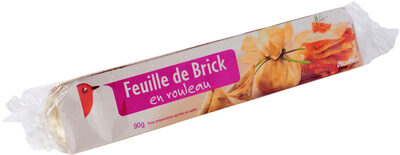Feuille de brick en rouleau - Auchan - 0.09 kg
This product page is not complete. You can help to complete it by editing it and adding more data from the photos we have, or by taking more photos using the app for Android or iPhone/iPad. Thank you!
×
Some of the data for this product has been provided directly by the manufacturer AUCHAN APAW.
Barcode: 3596710378128 (EAN / EAN-13)
Common name: Feuille de brick
Quantity: 0.09 kg
Packaging: Box
Brands: Auchan
Categories: Brick sheets
Labels, certifications, awards: Nutriscore
Stores: Auchan
Matching with your preferences
Environment
Packaging
Transportation
Other information
Preparation: :Ne pas utiliser le papier paraffiné comme papier cuisson .astuces de pliage:voir pièces jointes : fiche pliage feuille de brick.cuisson:à la poêle : faire chauffer de l'huile ou du beurre dans une poêle, garnir les feuilles de bricks selon vos envies et faire cuire 2 à 3 minutes de chaque côté. en friture : Garnir les feuilles de brick, les plonger dans l'huile bien chaude et laisser cuire jusqu'à ce qu'elles prennent un aspect doré. au four : préchauffer le four à 220°C (Th. 7/8), garnir les feuilles de brick, les badigeonner de beurre fondu ou d'huile, enfourner et faire cuire 5 minutes jusqu'à ce qu'elles prennent un aspect doré..facile et pratique:Ces feuilles de brick sont faciles à cuisiner. En entrée, en plat ou en dessert, garnies de façon sucrée ou salée, vous pourrez surprendre vos invités. .suggestion recette salée:mille-feuilles au saumon et à l'anethpréparation : 10min. / Cuisson : 5min.Pour 6 mille-feuilles•1 rouleau de feuilles de brick Auchan•30g de beurre•6 tranches de saumon fumé•30 cl de crème fraîche épaisse•½ bouquet d'aneth•Sel, poivrePréparation :Découper 4 carrés de 10 cm de côté. Les badigeonner de beurre fondu et les passer au four jusqu'à ce qu'ils soient légèrement dorés. Les sortir et laisser refroidir.Couper en lamelles les tranches de saumon fumé. Mettre la crème fraîche dans un bol et l'assaisonner.Poser un carré de brick dans une assiette. Le garnir de saumon fumé. Le recouvrir d'un carré de brick lui-même garni d'un peu de crème fraîche. Refaire par dessus une couche au saumon fumé. Terminer par un carré de brick. Décorer de quelques brins d'aneth. Procéder à l'identique pour les autres mille-feuilles. Servir immédiatement..suggestion recette sucrée:aumonière de fruits rougespréparation : 10 min. / cuisson : 8 min.•1 rouleau de feuilles de brick Auchan découpé aux dimensions désirées•une poignée de fruits rouges•1 cuillère à soupe de crème fraîche épaisse (penser à l'alternative avec le mascarpone)•2 carrés de chocolat•1 cuillère à café de poudre d'amande•1/2 cuillère à soupe de sucre glaceDisposer tous les ingrédients au centre de la feuille de brick, en commençant par les fruits rouges, la crème fraîche (ou le mascarpone), la poudre d'amande, les carrés de chocolat et terminer par le sucre glace.Refermer soigneusement, et nouez au besoin avec un petit fil de corde de cuisson. Ne pas trop serrer pour ne pas abîmer la feuille de brick.Badigeonner délicatement au pinceau l'aumônière avec du beurre fondu et enfourner 8 minutes à 200°C (Th. 6/7).
Conservation conditions: à conserver entre 0°C et +8°C
Report a problem
Data sources
The manufacturer AUCHAN APAW uses Agena3000 to automatically transmit data and photos for its products.
Product added on by kiliweb
Last edit of product page on by org-auchan-apaw.
Product page also edited by date-limite-app, desan, openfoodfacts-contributors, packbot, roboto-app, teolemon, yuka.PbVCLo7aHp0tQ_H9yNgF_WClSOTGP65yHC4qog, yuka.UzZjTVFKNGxwOWcya00wM3BqUHh5dGR2eTd1bEFHcU5jYkV4SUE9PQ.








